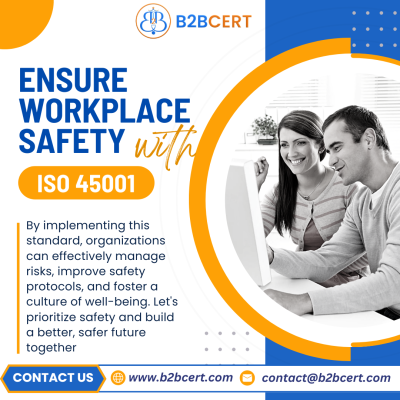What are the Requirements for Hazard Identification and Risk As
-
Hazard identification and risk assessment are the foundation of any effective Occupational Health and Safety (OH&S) management system. They provide organizations with the ability to systematically recognize potential hazards, evaluate the risks they pose, and establish effective controls to ensure worker safety. These processes are not only critical for protecting employees but also essential for organizations aiming to comply with international standards such as ISO 45001 Certification in Bangalore.
In this blog, we will explore the requirements for hazard identification and risk assessment, their importance, and how organizations can meet these obligations effectively.
Understanding Hazard Identification and Risk Assessment
-
Hazard Identification involves the process of recognizing anything that has the potential to cause harm, such as unsafe conditions, unsafe acts, machinery, chemicals, or even organizational practices.
-
Risk Assessment refers to evaluating the likelihood and severity of harm that may arise from these hazards and determining control measures to minimize or eliminate risks.
Together, they form the backbone of workplace safety, helping organizations proactively prevent accidents rather than reactively addressing incidents.
Requirements for Hazard Identification
ISO 45001 clearly outlines requirements that organizations must follow for effective hazard identification. Some of the essential requirements include:
1. Identify Hazards Across All Activities
Organizations must identify hazards linked to both routine and non-routine activities. This includes daily tasks, maintenance work, cleaning, emergencies, or even contractors working on-site.
2. Consider Human Factors
Human errors, stress, fatigue, or lack of training can significantly contribute to workplace hazards. Effective hazard identification requires analyzing how human behavior impacts safety.
3. Evaluate Workplace Conditions
This includes physical conditions like noise, temperature, lighting, and ergonomic risks, as well as chemical, biological, and psychosocial hazards.
4. Account for External Factors
External conditions such as environmental changes, supplier practices, or natural disasters can also create risks. Organizations must include these in their hazard identification process.
5. Involve Workers in the Process
Workers are often closest to the risks and can provide valuable insights. ISO 45001 encourages consultation and participation of employees in hazard identification.
Requirements for Risk Assessment
Risk assessment goes hand-in-hand with hazard identification and involves analyzing risks to decide on control measures. The following are key requirements:
1. Assess Likelihood and Severity
Organizations must assess how likely an incident is to occur and the severity of its consequences. This helps prioritize risks that need urgent attention.
2. Establish a Risk Evaluation Matrix
A structured risk evaluation matrix enables consistent measurement of risks, ensuring decisions are based on clear criteria.
3. Determine Legal and Regulatory Compliance
Risk assessments must consider compliance with national occupational safety laws and international standards like ISO 45001. Non-compliance can result in penalties and reputational damage.
4. Prioritize and Control Risks
Once risks are assessed, organizations must implement control measures based on the hierarchy of controls: elimination, substitution, engineering controls, administrative controls, and personal protective equipment (PPE).
5. Document and Review the Risk Assessment
Proper documentation provides evidence of compliance and ensures accountability. Risk assessments must be regularly reviewed to remain effective as processes, equipment, or working conditions change.
Benefits of Effective Hazard Identification and Risk Assessment
Meeting the requirements of hazard identification and risk assessment offers several benefits, including:
-
Improved Worker Safety: Reduces accidents, injuries, and occupational illnesses.
-
Legal Compliance: Ensures adherence to occupational health and safety regulations.
-
Enhanced Productivity: A safer workplace minimizes downtime caused by accidents.
-
Cost Savings: Preventing incidents reduces compensation claims and legal costs.
-
Facilitates ISO 45001 Certification in Bangalore: Demonstrates an organization’s commitment to employee safety and international best practices.
Role of ISO 45001 in Hazard Identification and Risk Assessment
ISO 45001 Certification in Bangalore provides a globally recognized framework for organizations to systematically manage workplace risks. It emphasizes continuous improvement, proactive risk management, and worker participation.
By implementing ISO 45001, organizations in Bangalore can:
-
Establish standardized processes for hazard identification and risk assessment.
-
Ensure compliance with both local laws and international OH&S standards.
-
Demonstrate their commitment to employee well-being, which enhances brand reputation.
Why Work with ISO 45001 Consultants in Bangalore?
Implementing ISO 45001 can be challenging without expert guidance. This is where ISO 45001 Consultants in Bangalore play a crucial role. Consultants assist organizations in:
-
Conducting detailed hazard identification and risk assessments.
-
Developing OH&S policies and procedures.
-
Training staff on risk management practices.
-
Preparing documentation and evidence for certification audits.
Their expertise ensures a smooth journey towards certification while strengthening an organization’s safety culture.
ISO 45001 Services in Bangalore
Organizations can also leverage ISO 45001 Services in Bangalore, which include gap analysis, internal audits, employee training, and end-to-end implementation support. These services ensure that businesses are well-prepared to meet certification requirements and maintain compliance over the long term.
Conclusion
Hazard identification and risk assessment are essential requirements for building a safe and healthy workplace. By systematically identifying hazards, assessing risks, and implementing control measures, organizations can protect employees, reduce incidents, and boost overall performance.
For companies in Bangalore, achieving ISO 45001 Certification demonstrates a strong commitment to occupational health and safety. With the support of professional ISO 45001 Consultants in Bangalore and comprehensive ISO 45001 Services in Bangalore, organizations can not only achieve compliance but also foster a culture of safety that drives long-term success.
-
